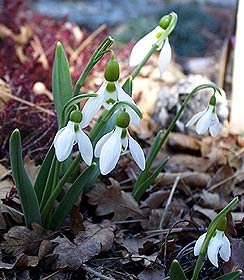Human Flower Project
Hovirag: Hungary’s Hot Snowdrop
The cherished emblem of early spring in Hungary is now off limits to sellers and embroiled in a national dispute over genetically modified plants.
 Young hovirag seller
Young hovirag seller
in Transylvania
c. 2005
Photo: Courtesy Gabor Miklosi
Our man in Budapest, journalist Gabor Miklosi, took a break from political muckraking this week to hunt for hovirag. Also known as snowdrops, Galanthus nivalis are the earliest blooming flowers in all of Hungary. Usually in February, they begin to appear on the streets of Budapest, sold by street vendors as tender harbingers of spring.
But the cherished hovirag custom was disrupted this year. “We experienced the most unusual winter,” Gabor writes, “It started off with the weather of early October lasting until Christmas, turning into that of late March immediately. People were selling hovirag as early as mid-January.”
When Gabor picked up his camera and went looking for snowdrops this past week, there were none to buy. “First I blamed it on global warming,” he says, “but I knew there was a better explanation, as flowers, unlike humans, are stubborn creatures that withstand difficult times.” Making inquiries like a true gumshoe, Miklosi found that disturbing wild hovirag flowers is now forbidden by law “as the irresponsible overpicking brought them to the verge of extinction. Some people were even detained for selling them earlier this year!”
 Hungarian prime minister
Hungarian prime minister
Ferenc Gyurcsany
(Are those hovirag legal, sir?)
The outspoken online Hungarian journal Pestiside reported that in early February, “customs officers found more than 21,000 snowdrops in a German van near Makó, south Hungary, with an incredible total street value of Ft 220 million (€870,000!!). The cargo has been confiscated and criminal proceedings are being brought against the driver for damaging the environment.”
We haven’t been able to determine precisely when or even if hovirag was placed on Hungary’s endangered species list. But this announcement from the World Wildlife Federation confirms the sad truth: that healthy hovirag is now so rare that environmentalists are mobilizing against the old rite of spring.
“Spring snowdrop bouquets awaken dear memories in everybody. Is there anything more beautiful than buying snowdrops for the beloved one?” So, if they’re not (yet) endangered, what’s the problem? The WWF has genetics professor Gábor Vida explain: ‘While the pollinating insects give the most conspicuous flowers the bigger chance of survival, man does precisely the inverse. He picks these, so only the poorer ones may ripen seeds. The snowdrop population suffers a loss both qualitatively and quantitatively.’” WWF Hungary and Duna-Ipoly National Park Authority are waging campaigns to make hovirag collecting illegal.
 Galanthus nivalis
Galanthus nivalis
known in Hungary as Hovirag
Photo: The Plant Expert
As if this stir weren’t enough, Galanthus nivalis is at the center of another Hungarian controversy. Esteemed biochemist Árpád Pusztai, a native of Hungary, was fired from his position with the Rowett Research Institute in Aberdeen for a remark about the safety of using a hovirag protein to make more disease-resistant potatoes.
“For years, Dr. Pusztai had explored the beneficial effects of lectins in foods as well as in nutritional supplements and pharmaceutical agents. Lectins can affect the digestive systems of insects and can act as natural insecticides. Arpad’s work had shown that one such lectin called GNA (Galanthus nivalis), isolated from the snowdrop, acted in this way.” Dr. Pusztai has been researching snowdrop lectin for almost twenty years.
Pusztai was told “not to talk about his experiments in detail,” but during a 1998 interview with Granada TV, he remarked that in rats that had been fed the experimental GNA potatoes, “the effect was slight growth retardation and an effect on the immune system. One of the genetically modified potatoes, after 110 days, made the rats less responsive to immune effects.’”
That comment sparked a blaze of investigations, recriminations, suspensions, and symposia.
And the controversy over snowdrop-potatoes bubbles on in Europe, where the larger issue of GM foods simmers on a front burner.
Thank you, Gabor, for alerting us to this beautiful flower of Hungary. (It’s just like you, to go kicking around an old custom and uncover controversy.)
Comments
All snowdrops, Galanthus species, as well as Cyclamen and Sternbergia (this last is an autumn-flowering golden yellow, crocus-looking flower bulb) are three bulbs under the Convention on the International Trade of Endangered Species, or CITES, Appendix II protection. This requires governmental level documentation for export / import of listed plants.
If you do pick snowdrops (in your own garden, to be sure) arrange the vase on a mirror, as suggested by Beverley Nichols. As he so wisely pointed out, the reflection of the flowers will double your pleasure.
Judy
Craig, thanks for connecting the dots (writers are dots, aren’t they?)
And Judy, thanks for clarification on the CITES requirements. I guess that truckload was headed out of Hungary for Germany, thus the arrest.
As for the suggestion of snowdrops on a mirror…ah—to live for that!
J.


Feast or famine. See recent Transatlantic Plantsman post ‘Snowdrops escaping from gardens – in the UK and USA’:
http://transatlanticplantsman.typepad.com/transatlantic_plantsman/2007/03/snowdrops_escap.html